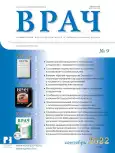Mast cells as predictors of bladder cancer
- Authors: Pavlova T.V.1, Atyakshin D.A.2, Pavlov I.A.1, Bessmertny D.V.1, Pilkevich N.B.1, Proshchaev K.I.1
-
Affiliations:
- Belgorod State National Research University
- N.N. Burdenko Voronezh State Medical University
- Issue: Vol 33, No 9 (2022)
- Pages: 58-61
- Section: From Practice
- URL: https://journals.eco-vector.com/0236-3054/article/view/114689
- DOI: https://doi.org/10.29296/25877305-2022-09-11
- ID: 114689
Cite item
Abstract
Objective. To investigate mast cell populations in patients of different ages with Stage li-ill bladder cancer (BC), by using innovative immunohistochemical approaches (to study chymase and thymase of positive structures). Subjects and methods. Immunohistochemical approaches were used to examine material from 25 patients: a study group of 20 patients with histologically verified Stage ll-lll bladder cancer; a control group of 5 men aged 36-50years without cancer who died in traffic accidents. Results. The investigation ofthe protease profile of a mast cell population in the bladder showed that during the process of cancer development, the time course of changes In the content of protease-posltive mast cells was different: the number of tryptase-positlve mast cells Increased, while that of chymase-positive mast cells significantly decreased. An analysis ofthe protease profile indicated that with the process of cancer development, mast cell chymase expression noticeably decreased; the size of mast cells in the connective tissue subpopulation reduced. However, they could form local intraorganlc accumulations, secreting both tryptase and chymase in fairly immense areas.
Keywords
Full Text
About the authors
T. V. Pavlova
Belgorod State National Research University
Author for correspondence.
Email: pavlova@bsu.edu.ru
доктор медицинских наук, профессор
D. A. Atyakshin
N.N. Burdenko Voronezh State Medical University
Email: pavlova@bsu.edu.ru
Research Institute of Experimental Biology and Medicine
I. A. Pavlov
Belgorod State National Research University
Email: pavlova@bsu.edu.ru
кандидат медицинских наук
D. V. Bessmertny
Belgorod State National Research University
Email: pavlova@bsu.edu.ru
кандидат медицинских наук
N. B. Pilkevich
Belgorod State National Research University
Email: pavlova@bsu.edu.ru
доктор медицинских наук, профессор
K. I. Proshchaev
Belgorod State National Research University
Email: pavlova@bsu.edu.ru
доктор медицинских наук, профессор
References
- Пристром M.C., Пристрои С.Л., Семенков И.И. Старение физиологическое и преждевременное: современный взгляд на проблему. Медицинские новости. 2015; 2:36-45.
- Онкогеронтология. Руководство для врачей. Под ред. В.Н. Анисимова, А.М. Беляева. СПб: Издательство AHHM0 «Вопросы онкологии», 2017; 509.
- Злокачественные новообразования в России в 2020 года (заболеваемость и смертность). Под ред. А.Д. Каприна, В.В. Старинского, А.О. Шахзадовой. М.: МНИОИ им. П.А. Герцена - филиал ФГБУ «НМИЦ радиологии» Минздрава России, 2021; 252 с.
- Павлова Т.В., Пилькевич Н.Б., Бессмертный Д.В. и др. Особенности метаболического атилизма при развитии онкологической патологии мочеполовой системы. Молекулярная медицина. 2021; 19 (31): 30-4. D01:10.29296/24999490-2021 -01-04
- Клинические рекомендации. Рак мочевого пузыря. Кодирование по Международной статистической классификации болезней и проблем, связанных со здоровьем: С67. Возрастная группа: взрослые. 2020; с. 81.
- Бухвалов И.Б., Атякшин Д.А, Павлова Т. В. и др. Гистохимия. Воронеж: Научная книга, 2018; 238 с.
- Павлова Т.В., Куликовский В.Ф., Павлова Л.А. Клиническая и экспериментальная морфология. М.: ООО Медицинское информационное агентство, 2018; 256 с.
- Buchwalow, I.B., Boecker W. Immunohistochemistry: Basics and Methods, 19 ed. Berlin, Heidelberg (Germany), Dordrecht (Netherlands), London (UK), New York (USA): Springer, 2010; 152 p.
- Atiakshin D.A., Shishkina V.V., Gerasimova O.A. et al.Combined histochemical approach in assessing tryptase expression in the mast cell population. Acta Histochem. 2021; 123:151-71. doi: 10.1016/j.acthis.2021.151711
Supplementary files









